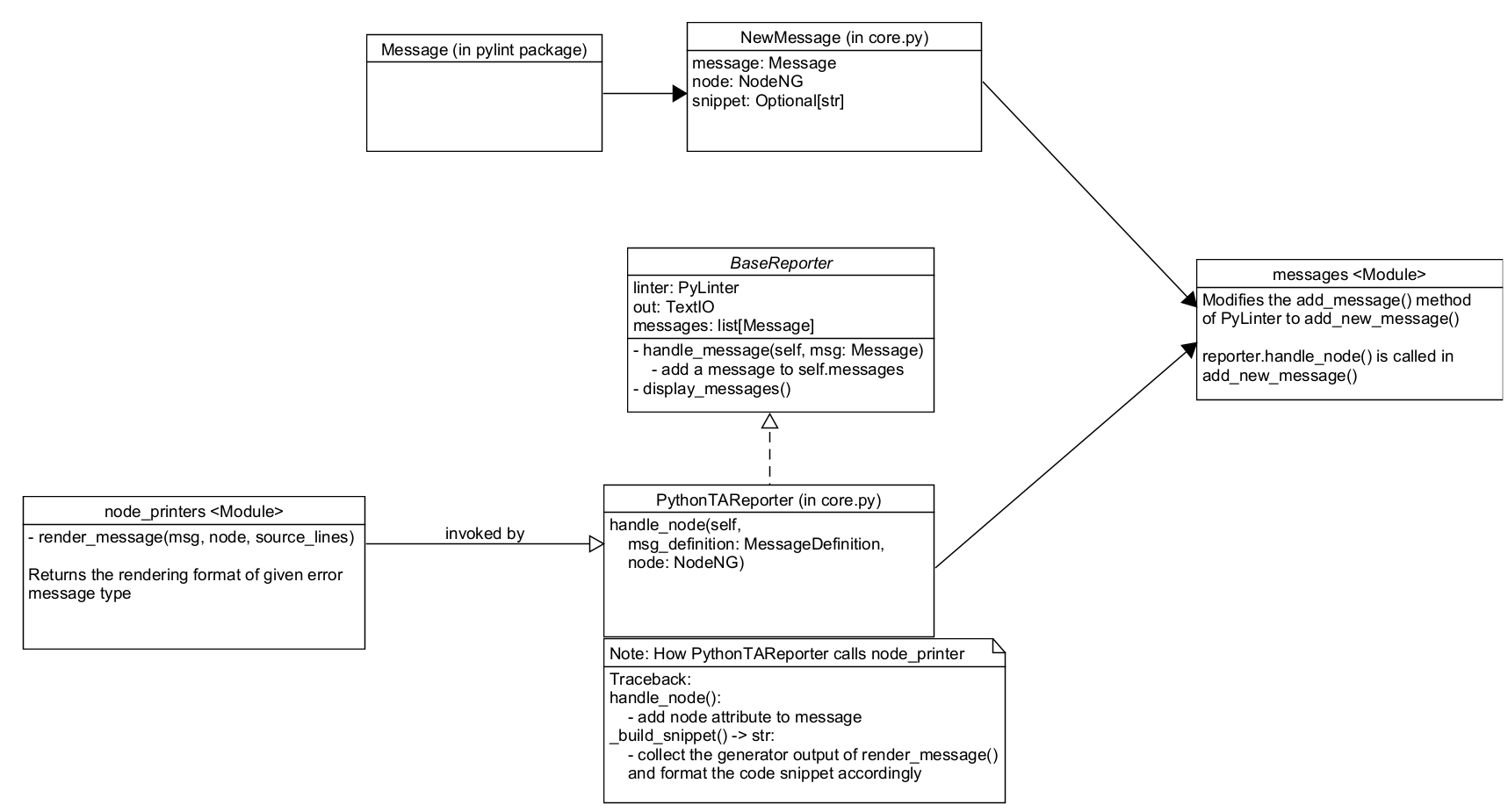PyTA Project: Add Test Cases to Pycodestyle Checker
 Raine
RaineIn this task, we will improve test coverage rate of node_printer.py module in PythonTA (https://github.com/pyta-uoft/pyta) by adding unit tests to uncovered cases in Pycodestyle checker.
What Does node_printers.py Module Do
The module we need to test, node_printer.py (located at /python_ta/reporters/node_printer.py), is used to specify how the code snippets with errors should be highlighted. In most cases, we can just highlight the entire line that contains the error. However, in some cases, we may want to provide additional comments or highlight only part of the line that contains the error to provide clearer information, for example:

node_printer.py stores a dictionary that contains all the error types that need special highlighting format (note that some of the types also contain sub-types), and corresponding callback functions to handle specific formatting for each error.
CUSTOM_MESSAGES = {
"missing-module-docstring": render_missing_docstring,
"missing-class-docstring": render_missing_docstring,
"missing-function-docstring": render_missing_docstring,
"trailing-newlines": render_trailing_newlines,
"trailing-whitespace": render_trailing_whitespace,
"missing-return-type": render_missing_return_type,
"too-many-arguments": render_too_many_arguments,
"missing-space-in-doctest": render_missing_space_in_doctest,
"pep8-errors": render_pep8_errors,
}
The task is to write unit tests for branches of node_printer.py that are not covered. According to the Coveralls report, the errors being untested include:
E115: Expected an indented block (comment)
E122: Continuation line missing indentation or outdented
E127: Continuation line over-indented for visual indent
E131: Continuation line unaligned for hanging indent
E125: Continuation line with same indent as next logical line
E129: Visually indented line with same indent as next logical line
E223: Tab before operator
E224: Tab after operator
E227: Missing whitespace around bitwise or shift operator
E228: Missing whitespace around modulo operator
E265: Block comment should start with '# '
E266: Too many leading '#' for block comment
E275: Missing whitespace after keyword
E301: Expected 1 blank line, found 0
E303: Too many blank lines (5)
E304: Blank line found after function decorator
How node_printers.py Is Being Called
Before we write tests to node_printers.py, we need to first figure out how it interacts with the larger system, in other words, who are the callers of its functions that format the highlights. A look into node_printers.py reveals that render_message() its only "public" function that should be called by external classes. This method returns the appropriate rendering of the message based on the message type.
def render_message(msg, node, source_lines):
"""Render a message based on type."""
renderer = CUSTOM_MESSAGES.get(msg.symbol, render_generic)
yield from renderer(msg, node, source_lines)
The reason why yield from instead of return statement is used (based on my best guess, since I didn't look into the specific functions in detail) is probably due to the need to retain certain internal states (such as local variables) of rendering functions among multiple calls. yield statement is similar to return, except that it does not immediately exit the function after returning the value. Instead, after yield statement, the function is suspended and returns the value, but all its states are stored. When the function is called again, it resumes from the point after the previous yield call. This mechanism provides a lightweight alternative to storing the internal states in a class.

render_message() method's only caller is PythonTAReporter class, which inherits BaseReporter from Pylint. render_message() is called by its private method _build_snippet() that collects the generator returned by render_message() and returns the formatted code snippet for display. _build_snippet() is then called by handle_node(), which adds node attributes to the message for reporter.
The caller of handle_node() is the overriden version of add_message()method in Pylinter. add_message() is a method in Pylinter that converts the message class emits by checkers (MessageDefinition) to that received by reporters (Message) PythonTA provides a decorator over Message called NewMessage that adds additional attributes for PythonTA report display. In the module messages, the add_message() method in Pylinter is reassigned to a function called new_add_message() that converts MessageDefinition to NewMessage and calls handle_node().
def patch_messages():
"""Patch PyLinter to pass the node to reporter."""
old_add_message = PyLinter.add_message
def new_add_message(
self,
msg_id,
line=None,
node=None,
args=None,
confidence=UNDEFINED,
col_offset=None,
end_lineno=None,
end_col_offset=None,
):
old_add_message(
self, msg_id, line, node, args, confidence, col_offset, end_lineno, end_col_offset
)
msg_info = self.msgs_store.get_message_definitions(msg_id)[0]
# guard to allow for backward compatability with Pylint's reporters
if hasattr(self.reporter, "handle_node"):
self.reporter.handle_node(msg_info, node)
PyLinter.add_message = new_add_message
Finally, patch_message() is included in patch_all() method of patches module, which is invoked in the __init__ method of python_ta module. Thus, PythonTA will modifies the add_message() method of pylinter during initialization.
# in patches/__init__.py
def patch_all(messages_config: dict):
"""Execute all patches defined in this module."""
patch_checkers()
patch_ast_transforms()
patch_messages()
patch_error_messages(messages_config)
In conclusion, renderer functions in node_printer.py will be triggered whenever a corresponding error message is being reported by PyLinter.add_message(). Therefore, what we need to do is to write test cases that trigger that pep8 errors.
Pylint Debug Module
Pylint provides pylint.testutils.CheckerTestCase package to implement unit tests for pylint checkers. Documentations and example implementations of Pylint checkers can be found here:(https://pylint.pycqa.org/en/latest/development_guide/how_tos/custom_checkers.html#testing-a-checker)
Below is part of source code of CheckerTestCase class. This class provides two unit test methods, assertAddsMesage and assertNoMessage, used to check cases when an error occurs or no error occurs, respectively.
# in pylint/testutils/functional/checker_test_case.py
class CheckerTestCase:
"""A base testcase class for unit testing individual checker classes."""
# TODO: Figure out way to type this as type[BaseChecker] while also
# setting self.checker correctly.
CHECKER_CLASS: Any
CONFIG: dict[str, Any] = {}
def setup_method(self) -> None:
self.linter = UnittestLinter()
self.checker = self.CHECKER_CLASS(self.linter)
for key, value in self.CONFIG.items():
setattr(self.checker.linter.config, key, value)
self.checker.open()
@contextlib.contextmanager
def assertNoMessages(self) -> Iterator[None]:
"""Assert that no messages are added by the given method."""
with self.assertAddsMessages():
yield
@contextlib.contextmanager
def assertAddsMessages(
self, *messages: MessageTest, ignore_position: bool = False
) -> Generator[None, None, None]:
"""Assert that exactly the given method adds the given messages.
The list of messages must exactly match *all* the messages added by the
method. Additionally, we check to see whether the args in each message can
actually be substituted into the message string.
Using the keyword argument `ignore_position`, all checks for position
arguments (line, col_offset, ...) will be skipped. This can be used to
just test messages for the correct node.
"""
yield
got = self.linter.release_messages()
no_msg = "No message."
expected = "\n".join(repr(m) for m in messages) or no_msg
got_str = "\n".join(repr(m) for m in got) or no_msg
msg = (
"Expected messages did not match actual.\n"
f"\nExpected:\n{expected}\n\nGot:\n{got_str}\n"
)
assert len(messages) == len(got), msg
for expected_msg, gotten_msg in zip(messages, got):
assert expected_msg.msg_id == gotten_msg.msg_id, msg
assert expected_msg.node == gotten_msg.node, msg
assert expected_msg.args == gotten_msg.args, msg
assert expected_msg.confidence == gotten_msg.confidence, msg
if ignore_position:
# Do not check for line, col_offset etc...
continue
assert expected_msg.line == gotten_msg.line, msg
assert expected_msg.col_offset == gotten_msg.col_offset, msg
if not IS_PYPY or PY39_PLUS:
assert expected_msg.end_line == gotten_msg.end_line, msg
assert expected_msg.end_col_offset == gotten_msg.end_col_offset, msg
One thing worth noting is that CheckTestCase initializes its own pylinter from UnittestLinter, whose source code is as follows:
class UnittestLinter(PyLinter):
"""A fake linter class to capture checker messages."""
def __init__(self) -> None:
self._messages: list[MessageTest] = []
super().__init__()
def release_messages(self) -> list[MessageTest]:
try:
return self._messages
finally:
self._messages = []
def add_message(
self,
msgid: str,
line: int | None = None,
# TODO: Make node non optional
node: nodes.NodeNG | None = None,
args: Any = None,
confidence: Confidence | None = None,
col_offset: int | None = None,
end_lineno: int | None = None,
end_col_offset: int | None = None,
) -> None:
"""Add a MessageTest to the _messages attribute of the linter class."""
# If confidence is None we set it to UNDEFINED as well in PyLinter
if confidence is None:
confidence = UNDEFINED
# Look up "location" data of node if not yet supplied
if node:
if node.position:
if not line:
line = node.position.lineno
if not col_offset:
col_offset = node.position.col_offset
if not end_lineno:
end_lineno = node.position.end_lineno
if not end_col_offset:
end_col_offset = node.position.end_col_offset
else:
if not line:
line = node.fromlineno
if not col_offset:
col_offset = node.col_offset
if not end_lineno:
end_lineno = node.end_lineno
if not end_col_offset:
end_col_offset = node.end_col_offset
self._messages.append(
MessageTest(
msgid,
line,
node,
args,
confidence,
col_offset,
end_lineno,
end_col_offset,
)
)
@staticmethod
def is_message_enabled(*unused_args: Any, **unused_kwargs: Any) -> Literal[True]:
return True
UnittestLinter inherits PyLinter and provides an additional method release_message() used to return self._messages. However, one concern I had is that UnittestLinter defines its own add_message() method . Since the module we want to test node_printer, is only invoked by the modified add_message() for pylinter in PythonTA, and PythonTA does not implement any overrides to pylint/testutils, it remains uncertain whether the unit test will invoke the modified add_message() . This part requires further confirmation and I will update this article if necessary.

Writing Tests for node_printer.py
The errors listed above all belong to pep8 errors, and are checked by PycodestyleChecker. PycodestyleChecker inherits BaseRawFileChecker in Pylint, meaning that it directly analyzes file text without building AST, and invokes pycodestyle to check for errors.
"""Checker for the style of the file"""
from typing import List, Tuple
import pycodestyle
from astroid import nodes
from pylint.checkers import BaseRawFileChecker
from pylint.lint import PyLinter
class PycodestyleChecker(BaseRawFileChecker):
"""A checker class to report PEP8 style errors in the file.
Use options to specify the list of PEP8 errors to ignore"""
name = "pep8_errors"
msgs = {"E9989": ("Found pycodestyle (PEP8) style error %s at %s", "pep8-errors", "")}
options = (
(
"pycodestyle-ignore",
{
"default": (),
"type": "csv",
"metavar": "<pycodestyle-ignore>",
"help": "List of Pycodestyle errors to ignore",
},
),
)
def process_module(self, node: nodes.NodeNG) -> None:
style_guide = pycodestyle.StyleGuide(
paths=[node.stream().name],
reporter=JSONReport,
ignore=self.linter.config.pycodestyle_ignore,
)
report = style_guide.check_files()
for line_num, msg, code in report.get_file_results():
self.add_message("pep8-errors", line=line_num, args=(code, msg))
class JSONReport(pycodestyle.StandardReport):
def get_file_results(self) -> List[Tuple]:
self._deferred_print.sort()
return [
(line_number, f"line {line_number}, column {offset}: {text}", code)
for line_number, offset, code, text, _ in self._deferred_print
]
def register(linter: PyLinter) -> None:
"""Required method to auto-register this checker to the linter"""
linter.register_checker(PycodestyleChecker(linter))
The unit tests for PycodestyleChecker lies in file pyta/tests/test_custom_checkers/test_pycodestylecheckers.py. There already exists a list of unit tests for other errors, and all we need to do is to imitate the format to implement tests for uncovered errors.
import os
import pylint.testutils
from astroid.astroid_manager import MANAGER
from python_ta.checkers.pycodestyle_checker import PycodestyleChecker
DIR_PATH = os.path.join(__file__, "../../../examples/custom_checkers/e9989_pycodestyle/")
class TestPycodestyleChecker(pylint.testutils.CheckerTestCase):
CHECKER_CLASS = PycodestyleChecker
CONFIG = {"pycodestyle_ignore": ["E24"]}
def test_error_e123(self) -> None:
"""Tests that PEP8 error E123 closing bracket does not match indentation of opening bracket's line triggers"""
mod = MANAGER.ast_from_file(os.path.join(DIR_PATH, "e123_error.py"))
with self.assertAddsMessages(
pylint.testutils.MessageTest(
msg_id="pep8-errors",
line=3,
args=(
"E123",
"line 3, column 4: closing bracket does not match indentation of opening bracket's line",
),
),
ignore_position=True,
):
self.checker.process_module(mod)
def test_no_error_e123(self) -> None:
"""Tests that PEP8 error E123 closing bracket does not match indentation of opening bracket's line
is NOT triggered"""
mod = MANAGER.ast_from_file(os.path.join(DIR_PATH, "e123_no_error.py"))
with self.assertNoMessages():
self.checker.process_module(mod)
"""Unit tests for other errors"""
By analyzing the previously implemented tests, we can observe that for each error there are two tests: the error exists in one test and does not exist in the other. In addition, the source code to check are located in a different directory as specified in DIR_PATH.
Now we want to implement custom checker for E115: Expected an indented block (comment). This errors occurs when a comment in an indented block does not follow the indentation as the code. It would not lead to an indentation error (since it is a comment rather than source code being wrongly indented), but will reduces readability of the code.
Firstly, in pyta/examples/custom_checkers/e9989_pycodestyle/ directory, we create two test cases e115_error.py and e115_no_error.py, in which the comment is not indented in the former and correctly indented in the latter.
In e115_error.py:
if True:
# No indented block follows the colon
pass
In e115_no_error.py:
if True:
# Correctly indented block follows the colon
pass
Finally, we can implement our unit tests for the two cases above as follows:
def test_error_e115(self) -> None:
"""Test that PEP8 error E115 (Expected an indented block) is triggered"""
mod = MANAGER.ast_from_file(DIR_PATH + "e115_error.py")
with self.assertAddsMessages(
pylint.testutils.MessageTest(
msg_id="pep8-errors",
line=2,
args=("E115", "line 2, column 0: expected an indented block (comment)")
)
):
self.checker.process_module(mod)
def test_no_error_e115(self) -> None:
"""Test that PEP8 error E115 (Expected an indented block) is NOT triggered"""
mod = MANAGER.ast_from_file(DIR_PATH + "e115_no_error.py")
with self.assertNoMessages():
self.checker.process_module(mod)
Subscribe to my newsletter
Read articles from Raine directly inside your inbox. Subscribe to the newsletter, and don't miss out.
Written by
